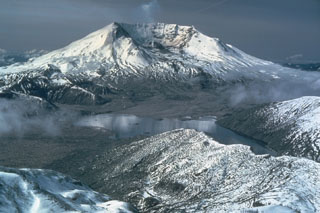Report on St. Helens (United States) — March 1981
Scientific Event Alert Network Bulletin, vol. 6, no. 3 (March 1981)
Managing Editor: Lindsay McClelland.
St. Helens (United States) Lava extrusion and small explosion follow deformation and seismicity
Please cite this report as:
Global Volcanism Program, 1981. Report on St. Helens (United States) (McClelland, L., ed.). Scientific Event Alert Network Bulletin, 6:3. Smithsonian Institution. https://doi.org/10.5479/si.GVP.SEAN198103-321050
St. Helens
United States
46.2°N, 122.18°W; summit elev. 2549 m
All times are local (unless otherwise noted)
March eruptive activity was limited to occasional emission of small steam clouds, at least one of which contained ash. However, significant deformation was measured within the crater, and there was a slight increase in volcanic seismicity during the second half of March. Geologists announced that another eruptive episode was likely if the deformation and seismic trends continued, but none had occurred by press time.
The USGS-University of Washington seismic net recorded fifteen bursts of seismicity in March and five more bursts during the first six days of April. In the past, similar signals have often been correlated with episodes of steam emission, but because of poor weather, correlations with only two such episodes could be confirmed in March: a minor puff on 9 March at 1549, and a steam cloud containing some ash on 27 March at 1441. Newly fallen ash (made up of reworked dome material) observed NE of the volcano 25 March may have been ejected during a burst of seismicity the previous day.
The seismic net began to detect small, low-frequency, shallow events on Mt. St. Helens on 21 March. Fifteen of these discrete volcanic events were recorded by the end of March. Numerous aftershocks of the M 5.5 tectonic event that occurred 13 February about 12 km N of Mt. St. Helens, continued to appear on seismic records through March.
Deformation measurements showed that outward movement of the N-crater rampart resumed in March. Between 9 and 17 March, the rampart moved 7 cm to the N; by 22 March it had advanced 6 cm farther northward; and an additional 3.5 cm of movement was measured by 24 March.
A newly-established leveling net on the crater floor showed pronounced uplift near the lava dome, indicating that the dome was rising. Increasing crater-floor deformation was also demonstrated by accelerations in the rate of widening of a fissure from 3 mm/day to l cm/day and the rate of movement of a thrust fault from 0.5 cm/day to 1 cm/day by late March.
Addendum: On 9 April at about 1800, local seismicity began to increase, to about 1 event per hour at first and to about 2/hr after midnight. The USGS-University of Washington team issued an advisory about midnight stating that an eruption was likely within the next day if seismicity continued to increase.
Periods of constant low-frequency seismicity became more common and by 0230 on 10 April low-frequency activity was continuous. Individual events superimposed on this activity had increased to an average of 6-8/hour by 0600 and remained at that level through the day. At 0821, a small explosion produced an ash-bearing plume that rose to 4.5 km altitude. A light ashfall was reported at a ranger station 40 km to the NE. Although clouds prevented observation of the crater, a USGS helicopter crew could see that this explosion had generated no pyroclastic flows.
About 1900, the pattern of seismic activity started to change. The number of discrete events dropped to 4-6/hr, but these events were slightly stronger and total seismic energy release briefly stayed about the same. However, by midnight there had been a notable decline in both the number of events and seismic energy release, and by 0200 only one to two events were being recorded per hour. Seismicity had essentially ended by 2100-2200 on 11 April.
The weather cleared somewhat late 12 April, and geologists were able to view the crater between 1800 and 1900. New lava extended roughly 75 m NNW from the pre-existing dome. Television station videotape taken between 1900 and 1930 showed significant additional lava extrusion.
Geological Summary. Prior to 1980, Mount St. Helens was a conical volcano sometimes known as the Fujisan of America. During the 1980 eruption the upper 400 m of the summit was removed by slope failure, leaving a 2 x 3.5 km breached crater now partially filled by a lava dome. There have been nine major eruptive periods beginning about 40-50,000 years ago, and it has been the most active volcano in the Cascade Range during the Holocene. Prior to 2,200 years ago, tephra, lava domes, and pyroclastic flows were erupted, forming the older edifice, but few lava flows extended beyond the base of the volcano. The modern edifice consists of basaltic as well as andesitic and dacitic products from summit and flank vents. Eruptions in the 19th century originated from the Goat Rocks area on the N flank, and were witnessed by early settlers.
Information Contacts: D. Swanson, C. Newhall, S. Russell-Robinson, USGS, Vancouver, WA; C. Boyko, A. Adams, S. Malone, E. Endo, C. Weaver, University of Washington; R. Tilling, USGS, Reston, VA.

